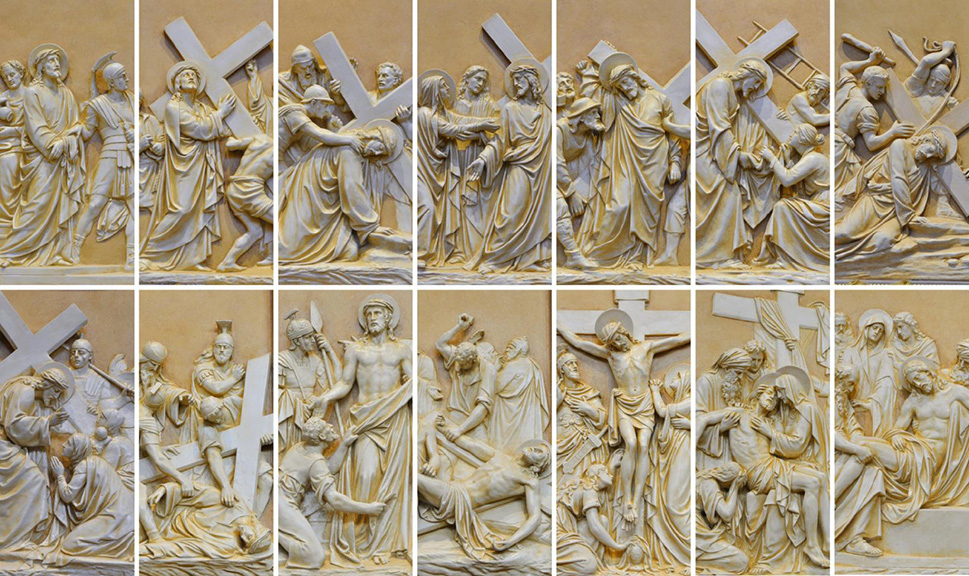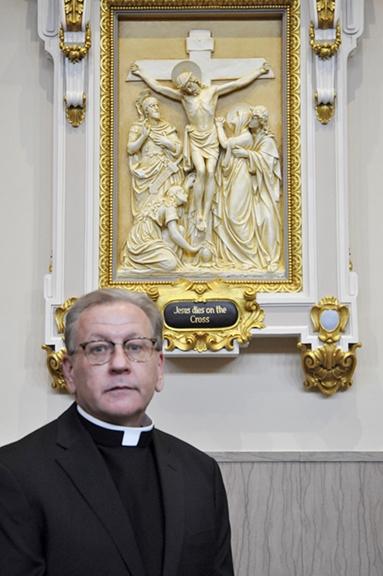
This article originally appeared in the Tennessee Register in February 2022
From partaking in the sacrament of reconciliation to fasting to choosing what to give up, Lent is full of traditions that Catholics around the world take part in as they prepare to celebrate Christ’s passion, death and Resurrection.
But there’s another sacred tradition that dates back to the early days of the Crusades; one that allows them to “walk” the Via Dolorosa with Christ: the Stations of the Cross.
The Stations of the Cross is a mini pilgrimage, which takes believers through the steps taken by Jesus on Good Friday, from his condemnation to his burial.
The Stations are a “way of prayerfully uniting oneself to the sacrifice of the Lord and his love for us,” said Father Eric Fowlkes, pastor of the Cathedral of the Incarnation. “It’s also an invitation for us to place ourselves within that journey.”
‘Where the devotion began’
The Stations of the Cross date back to the Middle Ages during the religious wars between Christians and Muslims, known as the Crusades.
“The Crusades awakened an interest in Europe in the places associated with Christ in the Holy Land. For the first time, Europeans were traveling there regularly and wanted to see the holy places where the Biblical events took place,” said Father Bede Price, pastor of Church of the Assumption. “One of those was, of course, the Via Dolorosa, which is the path that Christ took to Calvary, and there were certain spots along that path where things were said to have happened.
“The most famous one probably is Veronica” wiping the face of Christ, he continued. “That’s not in the Bible. It’s a legend, a story about a woman who had compassion on Christ and wiped his face with a veil. The word ‘Veronica’ simply means ‘a true icon’ and even that is tied to the Crusades because the legend of Veronica becomes part of the story of the Shroud of Turin. … These things are all part of the traditions that have been handed down” throughout the history of the Church.
But trips to the Holy Land weren’t easy ones to take for everyone in Europe, so the “people started erecting these stations in churches in Europe so they can virtually go on a pilgrimage to the Via Dolorosa,” Father Price said. “That’s where the devotion began.”
The devotion was further popularized by St. Francis of Assisi, Father Price said. And his version is just one of many that can be used for meditation today.
‘Discover what speaks to your heart’

Since its origins, several versions of the Stations of the Cross have been developed, and while in communal celebrations it’s designated by each church which version is used, believers have options for which version to use when praying them alone.
One of the most famous and widely known versions is the Stations of the Cross by St. Alphonsus Liguori.
“This traditional Way of the Cross combines meditations and prayers based on the Gospels to lead you through the passion and death of Jesus,” according to The National Shrine of The Divine Mercy official website.
“It is very traditional, and it is very biblical, quoting from the scriptures as you go along,” Father Fowlkes said. “I love the one by St. Alphonsus because, when I was converting to the Catholic faith” at the age of 16, “it was the version I heard at my first experience of the Stations of the Cross. I just found it to be very powerful and very prayerful.”
There is also a version which follows the Way of the Cross through the eyes of Mother Mary, which Father Price said Church of the Assumption parishioners pray each Advent season.
“You see the events of the stations through the eyes of Mary as if you’re walking the Via Dolorosa with her,” he said.
Other versions include those of St. John Henry Newman, the Way of the Cross for Children, the Stations of the Cross with St. John Paul II, and more.
“It’s a matter of preference and there are a variety of wonderful resources with different options for the Stations of the Cross,” Father Fowlkes said. “It’s about discovering the one that speaks to your heart.”
Each, at their core, have the potential for deep reflection and lessons.
‘Each has a lesson for us’
From new forms of meditation to inspiration for everyday life to connecting personally with a particular station, the priests agreed there are many lessons to be learned from the stations.
“The Stations of the Cross is very similar to the rosary in so far as you are saying the prayers, but you’re also supposed to be meditating on the mysteries. In the same way, we also meditate on the mysteries of the Stations of the Cross, and each one of them has a lesson for us,” Father Price said. “St. Veronica for instance would be a lesson for us to meditate on compassion, to suffer with, which is what the word compassion means. Do we suffer with Christ when we encounter our own difficult things?”
Father John O’Neill, pastor of Holy Trinity Church in Hohenwald, Christ the Redeemer Church in Centerville, and St. Cecilia Church in Waynesboro, said Veronica also provides insight into how we interact with others.
“We must be kind, we must be responsive and ready to receive and to give,” Father O’Neill said. It’s also a reminder that “God will always send somebody in the middle of the crowd that you never saw before,” he added.
The stations are also reminders of the perfect example of Christ and the depth of his love.
“Myself, I always wonder, ‘why did he fall three times?’ That’s a meditation because whenever numbers come up in the Catholic Church, they mean something,” Father Price said. “Three is a number which means perfection, so I think what it’s trying to say is Christ is the perfect penitent, the perfect model of penance in those three falls.”
“I love that Jesus falls three times,” Father O’Neill added. With each, “He falls for us.”
Father Fowlkes said there is always something new to be revealed in our personal faith journey each time we participate in the stations as well.

“If we are joining our lives to the Lord’s journey, there will always be new connections of our faith to Christ’s saving actions,” Father Fowlkes said. “For example, the fourth station, Jesus meets his afflicted mother. I’ve known this to happen that when a mother has lost a child, they often will find a very deep connection to that part of the Stations of the Cross because they are experiencing, personally, a very heavy burden and a deep loss. To unite that to their faith and to the sacrifice of Jesus, I think it’s something that becomes very personally meaningful.
“I think that’s true of all the stations. At different points in our lives, if we are spiritually attentive, we are going to connect to different parts of the message of the stations,” he continued. “Another is Simon carrying the cross. There will be times in life when we are grateful that someone is helping us carry our crosses, and there are other times when we have the opportunity to help people bear the burdens of their cross in life. In that, it becomes more than just about something in history, but it becomes something that is alive in our faith.”
‘Falling in love with Jesus’
As Catholics prepare to enter the sacred time of Lent and many return to the tradition of the Stations, the priests offered some final words of inspiration for their parishioners.
“My hope for them is that they can be renewed in their faith and see in that sacred journey of Christ a connection to their own pilgrimage of faith,” Father Fowlkes said.
“Lent is nothing more than about falling in love with Jesus again, and (the Stations of the Cross) is part of that love,” Father O’Neill said. Whenever Catholics gather in prayer, “we’re coming as a huge act of faith and trust in God. We’re saying, ‘We’re here, we still love you, and it still means everything to us.’”
Father Price said he hopes it inspires Catholics to practice the devotion beyond just Lent.
“We need to recapture the spirt of Lent on every Friday of the year,” Father Price said. “I think encouraging people to make visits to their parish churches on Fridays during the year and reciting the stations privately will put Lent into a bigger perspective. Life is a journey, not just Lent.”









